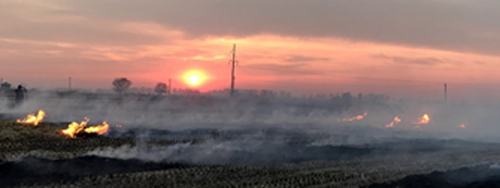Open biomass burning (OBB) has a significant impact on regional air quality, especially on the heavy haze pollution in Northeast China (NEC) in recent years. Recent research published in Atmospheric and Oceanic Science Letters provides scholars and decision-makers with a more comprehensive and long-term analysis of the spatiotemporal patterns of OBB in NEC.
By using the MODIS fire and land cover products, Dr. WANG Lili from the Institute of Atmospheric Physics, Chinese Academy of Sciences attempted to capture the spatial and temporal distribution of OBB in NEC from 2003 to 2017, as well as the corresponding proportion of fire points in different vegetation types.
The results show the changes in the total number of MODIS fire points in NEC from 2003 to 2017 demonstrated a fluctuating but generally rising trend, with the peak during 2013–2017.
"We found that most fire points concentrated in two key periods, i.e., March–April and October–November. OBB in Heilongjiang Province comprised a major proportion of the total number of fire spots in NEC, and the largest proportion of all fires was in cropland," says WANG.

Open agricultural fire in Northeast China (Image by Lili Wang)
According to this study, the cumulative emissions of PM2.5, NOx and NH3 from open agricultural burning reached up to 158.46 Gg, 49.50 Gg, and 27.00 Gg in March, April, October, and November during 2013–17, respectively. Significantly, the majority of OBB generally shifted from October–November to March–April for all three provinces and the amount of OBB in March–April was higher than that in October–November during 2016–17.
WANG suggests more effective utilization approaches for crop residue and strict policies should be taken to control the upward trend of crop residue burning in NEC, according to this study. In addition, prescribed in-situ burning could be an effective straw management strategy if farmers are reluctant to give up this traditional farming method.
Citation:
Lili WANG, Xin JIN, Qinglu WANG, Huiqin MAO, Qiyang LIU, Guoqing WENG & Yuesi WANG (2020) Spatial and temporal variability of open biomass burning in Northeast China from 2003 to 2017, Atmospheric and Oceanic Science Letters, 13 (3), doi: 10.1080/16742834.2020.1742574. https://doi.org/10.1080/16742834.2020.1742574
Media contact: Ms. LIN Zheng, jennylin@mail.iap.ac.cn
